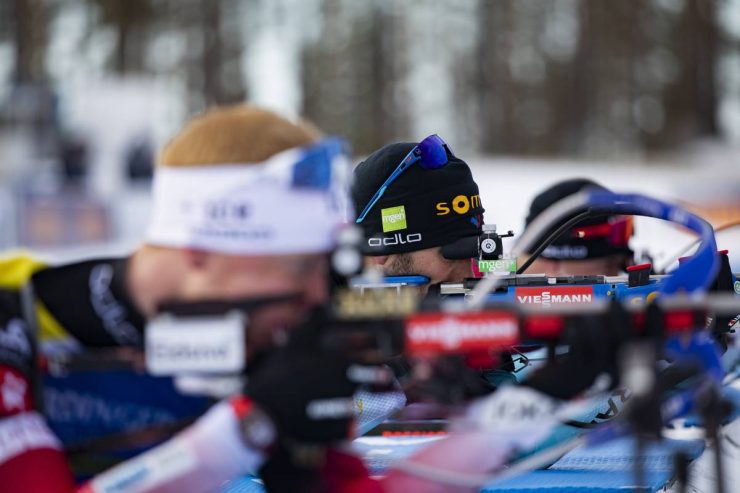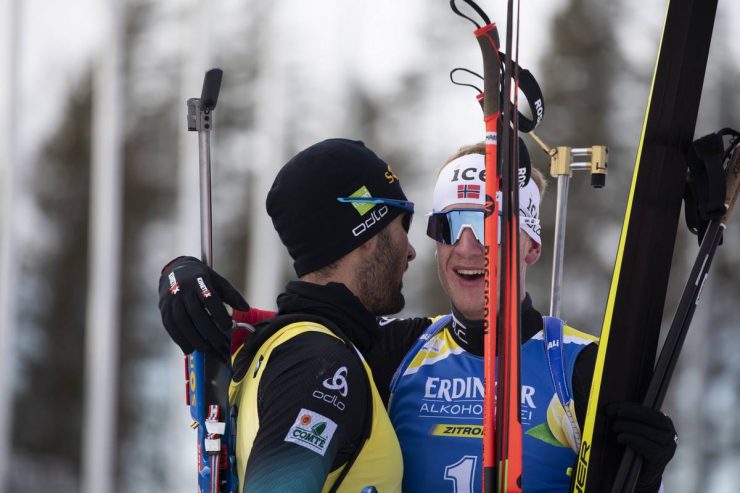A year ago Martin Fourcade was coming off the worst showing of his career, a cataclysm of a season leaving everyone who follows the sport scratching their heads. While he had two victories and another podium by Christmas, something was apparently wrong; his results declined after New Year’s and he wasn’t on the podium again for the rest of the season. He skipped the North American leg of the World Cup, raced World Champs, where it was especially egregious when he failed to medal, and then called it quits, missing the season finale at Holmenkollen. His actual results: twelfth in the overall rankings at the end of the year (after missing six races), and besides the already mentioned three podiums, he finished top ten in all but three races that he started.

What would have been a respectable season for just about anyone else was rock bottom for Fourcade. His showing that year is further contrasted by Johannes Thingnes Bø’s near perfection, winning 16 of 25 races en route to winning the overall title and each of the four discipline Crystal Globes. Bø’s year, however, can only be described as Fourcadeian, because what Bø did in the 2018-19 season was what was expected of Martin Fourcade every year he competed. Winning, all the time, second place being a disappointing race. Fourcade was the overwhelming favorite every time he lined up for a race. Fourcade owned the World Cup like no one else ever has.
Fourcade made his World Cup debut in 2008, where he finished 61st in a Sprint. It was the only World Cup he raced that year. The following season he was promoted and raced the whole season. His results weren’t extraordinary, but he was only 20 years old, and did make it to the podium once as the third leg on France’s relay team, and he finished the year 24th on the overall ranking. He started the 2009-10 season relatively quietly but had a series of top tens on the World Cup leading up to the Olympics. He had a mediocre showing in the first three races, but in the mass start, the last race, Fourcade took his first podium at the highest level with a silver medal at the Olympics.

It’s a spectacular race to watch. Fourcade starts with bib 16, and in maybe 200 meters he’s at the front. He leads coming into the first shooting stage, misses twice, putting him 50 seconds behind, and watching it on TV you wouldn’t expect to get a glimpse of him again until he crossed the finish line. After the second lap, he shoots clean but is still in 28th (out of 30). The camera stays with the leaders. There’s a group of nine or so at the front and the chase is strung out. A kilometer and a half later there’s an intermediate time check and the camera lingers at the top of the climb, and then suddenly Fourcade blasts into view, hammering almost at a jump skate where everyone around him is in a controlled V1, and Fourcade’s in roughly 16th place and has cut his deficit almost in half, and by the time they get to the range he’s made contact with the lead group. He shoots slow but shoots clean, and the gap is at 22 seconds. He brings it down to 14 coming into the last shooting stage, where later on in his career he would build a reputation for clutch performance, but not this time, he misses once, and leaves the penalty loop in fifth place and an impossible 26 seconds back. But now it’s a ski race and Fourcade takes no prisoners. He blows by fourth-place without even turning his head, and it takes him maybe 500 more meters to get to third, drops him immediately, and he’s got a medal secure but he keeps charging. Somehow he passes second place too and has his eyes on gold, but he runs out of trail before he can catch up and just misses the top step of the podium.
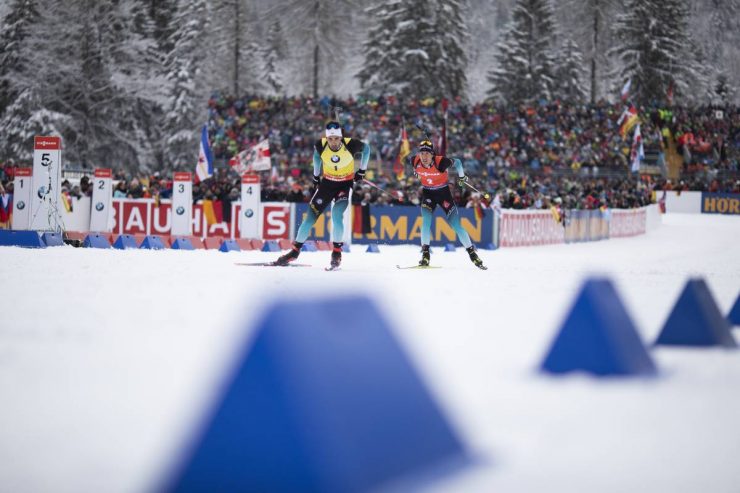
So began Fourcade’s stranglehold on the biathlon world. He won his first little Crystal Globe that year in the Pursuit discipline, along the way taking three World Cups in a row. He was third overall the following season, and the year after, 2011-12, he won his first of seven consecutive overall titles.
Once there is enough popular consensus for an athlete to be proclaimed the GOAT (greatest of all time) of their sport, they get entrenched in that position and it becomes difficult to have a conversation about someone else surpassing them. An example, suggesting that LeBron James may have passed Michael Jordan as the best basketball player ever is pretty much heretical. This exists in biathlon too. We have a colossus of the sport in Ole Einar Bjørndalen, the most decorated male Winter Olympian ever, and ask just about anyone who knows anything about the sport and they’ll tell you he’s the best ever. His nickname is the ‘King of Biathlon’, after all. With that being said, you heard it here first: Fourcade was better than
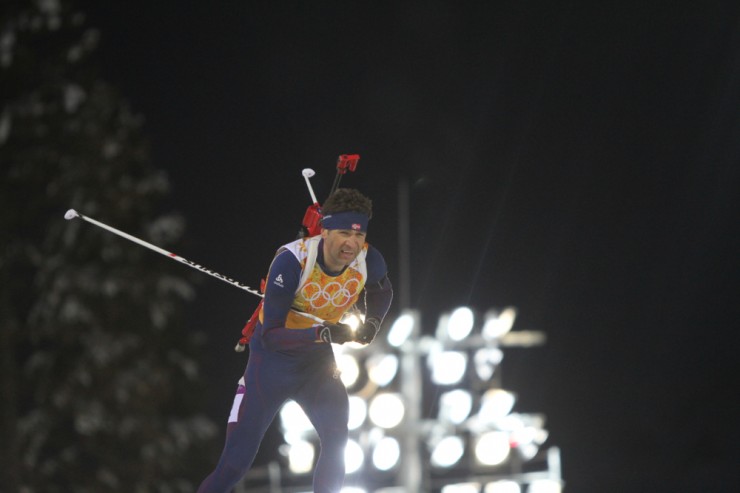
Nordic sports are resistant to analytics by nature. (The statisticalskier.com stuff republished on FasterSkier this year is the only time I’ve ever seen any sort of real statistical analysis of ski racing.) Without a ton of statistics outside of win tallies, it can be difficult to assess athletes from different eras, and as far as Bjørndalen and Fourcade, taking a head-to-head of the races they were both in is probably not the best comparison, because Bjørndalen was damn near geriatric when Fourcade started winning.
But I’m going to go ahead and use what stats I can. (Note the totals listed do not include any relay results.) So let’s start with overall Crystal Globes. In 24 seasons, Bjørndalen had six overall titles and seven top-threes; in 12 seasons, Fourcade had seven overall titles and two more podiums.* (25% wins and 54% podiums for Bjørndalen; 58% wins and 75% podiums for Fourcade.) A percentage comparison may seem unfair because Bjørndalen raced into his forties while Fourcade retired at 31, athletic prime, but regardless, in half as many seasons Fourcade won more Crystal Globes. And if we factor in discipline titles it’s even more outrageously in Fourcade’s favor. Bjørndalen has twenty discipline titles; Fourcade has 26.† And Fourcade accomplished something Bjørndalen never did when he swept every discipline title in 2013. That’s five Crystal Globes in one season. And he did it three more times after that. If instead, we look at individual World Cup races (this includes all World Cups, World Champs, and the Olympics), Bjørndalen holds the IBU record with 95 wins and 179 total podiums in 421 starts. Fourcade is second all-time with 83 wins and 150 podiums in 243 starts. (Bjørndalen: 12% and 43%; Fourcade: 34% and 62%). If he kept racing for another season or two Fourcade stood a very good chance of passing Bjørndalen.
And for emphasis, again: Martin Fourcade was on the podium in 62% of his starts.
We can also compare results at major championships, given that those are usually assigned more weight than the World Cup. So, Bjørndalen raced 69 races at World Championships, collecting 11 gold medals and 26 podiums; Fourcade, in 36 starts, garnered 11 golds and 18 podiums. (16% and 38% for OEB, 31% and 50% for MF.)‡ At the Olympics, Bjørndalen has 5 golds and 9 podiums in 19 races; Fourcade has 4 golds and 6 podiums in 12 races. (OEB: 26% and 47%; MF: 33% and 50%.) I’m calling this one a draw; while Fourcade was on the podium more often, Bjørndalen deserves some commendation for getting medals well beyond his fortieth birthday, and also note that Bjørndalen stepped up his game at the Olympics, while Fourcade pretty much stayed consistent (though Fourcade was much better than Bjørndalen at World Champs).
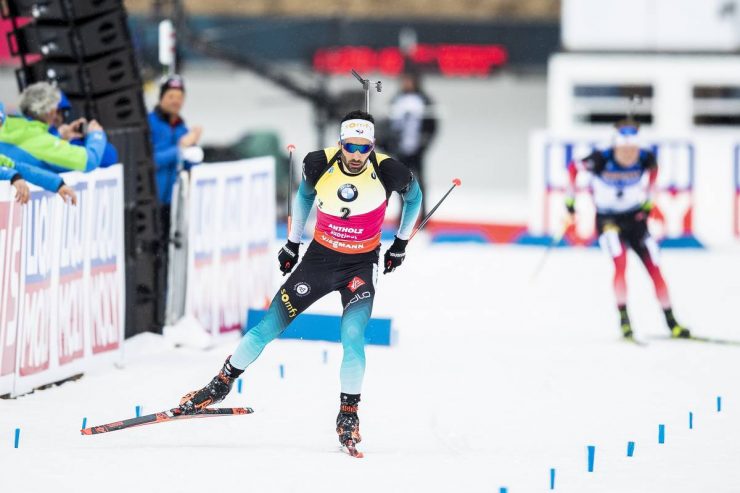
The long and short of it all is that Fourcade won more than Bjørndalen in a career that spanned half as much time. Comparing the two men’s achievements, Fourcade was better on the World Cup, achieving a consistency Bjørndalen never quite had and was just as successful at World Champs and the Olympics. Bjørndalen racked up more hardware due to his seemingly supernatural longevity, but peak Fourcade was an unstoppable force of a caliber the sport had not yet seen.
Martin Fourcade should be remembered as the most dominant biathlete to ever compete. He won the 2013 World Cup by 400 points. On a regular basis, he had such a big lead in the overall standings his Crystal Globe would be wrapped up weeks before the end of the season. He held the yellow bib for two and a half years straight from 2012 to 2014. He won in every discipline and rarely had bad days (and even then he was still good). Nobody was ever surprised when the last lap of a race turned into a formality after Fourcade entered the range with a thirty-second lead and shot clean, administering the coup de grace for anyone who thought they had a chance, Fourcade pumping his fist in the air before he put his rifle on his back, the final lap now his victory lap, carrying the Tricolour across the line. Though let’s be honest, he could’ve missed the last shot and he still would have won. If he missed twice, maybe he could be beaten. He was the strongest skier on the World Cup and one of the best shooters.§

So this was Fourcade’s final season, though he didn’t announce it until March 13, in the middle of what would be his last race weekend. As a fan, it was, without a doubt, the best season since I started following the sport. Fourcade had triumphantly returned to form, though for the first time in a long time (disregarding last year) somebody was actually skiing faster than Fourcade. Bø took the first race, Fourcade took the second. Bø then won four of the next five. Then Fourcade won four in a row. Each of them had held the yellow bib twice by mid-January. Each had a gold at World Champs, with Bø’s coming on the last race, and then he won the next three World Cups, ending with the Sprint in Kontiolahti, edging Fourcade in second.
After the pursuit, there should have been three more races but the season was cut short for Coronavirus and who knows what would have happened because it was so close between the two of them. Fourcade didn’t control his own fate going into that last race; if Fourcade won Bø needed fourth to take the overall. And fourth is what he got. The final tally: 913 points for Bø, 911 for Fourcade. So Fourcade didn’t get the crystal globe but he won the last race of his career, skiing into the hauntingly empty grandstands in Kontiolahti, the place where he’d won his first World Cup ten years prior to the day, after characteristically leaving the range with an insurmountable lead, the fairytale ending to the greatest career we’d ever seen, made complete with a podium sweep for France. As his successor, Fourcade leaves Johannes Thingnes Bø who, at 26, is certainly the best male biathlete on the planet, and perhaps well on his way equaling Fourcade’s seven consecutive big Crystal Globes. But for now, au revoir to Martin Fourcade, the best there ever was, the rightful King of Biathlon.
*I’m not counting either athlete’s first season, when they competed in two and one World Cup races, respectively. I am counting Bjørndalen’s last and Fourcade’s second to last, when they both missed a significant number of races.
† I suppose I need to mention that the Pursuit didn’t exist until 1996 and the Mass Start wasn’t around until 1998, Bjørndalen’s fifth and seventh seasons. So while that’s ten fewer opportunities for a discipline title, it’s unlikely he would have won any of those even if they had existed, given his other results from that time. His first Pursuit Globe came in 2000 and his first Mass Start in 2003.
‡ The IBU holds World Championships every year except for Olympic years. There’s usually a significant lag between when a new event is added to the IBU rulebook and World Championships, and its inclusion on the Olympic program, so the IBU has hosted a standalone ‘World Championship’ for those events in Olympic years. For instance, the Mass Start did not make it onto the Olympic program until 2006, so there was only a Mass Start World Championship in 2002. More recently, the mixed relay was not contested at the 2010 Olympics, so there was a single World Championship event held during the final World Cup weekend (kind of like how the 50k/30k at Spring Series are National Championship events while the other races are plain old Super Tours). Some sources don’t count these as World Championships, instead of listing them just as World Cups, but I’m including them in my World Championship medal count here.
§ It goes without saying that the best skier/best shooter would be the best biathlete, but there’s a little more nuance than that, and this is probably the reason Fourcade was ultimately better than Bjørndalen. Both were the best skiers of their time, but the gap between Bjørndalen and whoever was number two, skiing-wise, was just astronomical, while Fourcade did occasionally get out skied. (Remember, Bjørndalen once won a cross-country World Cup and had a couple other podiums. Fourcade, if you’re curious, did score points in a cross-country World Cup, finishing 22nd in a 10k in 2015.) But Fourcade consistently shot over 90% during his career, while Bjørndalen was usually mid-80s. Hence why, in this writer’s opinion, Bjørndalen had considerably more success in Sprints, which favor strong skiing, than the Individual, which is much more of a ‘shooter’s race’. So basically what I’m saying is if Bjørndalen had just shot a little better, he might have won every Crystal Globe for twenty years straight.

